- Conversion copywriting,
- Email marketing strategy,
- Research & discovery,
- Website audits
"Help!"
Ah, the familiar cry from a brand paying too much per sale from their digital ads…
It’s also the subject line of an email that landed in my inbox in late 2018.
To save time and advertising funds, I recommended a well-planned email campaign and website optimisation project.
(Emailing existing subscribers has a higher potential return on investment (ROI) than any other marketing activity, and there’s no extra cost once the emails are written and scheduled).
The sales email sequence I planned and wrote for this client more than doubled their open and click-through rates.
This case study will walk you through the process and results.
Finding out about the brand, the audience and the setup
Our client had not done any surveys or customer interviews in over 12 months. There were hundreds of anonymous subscribers on their email list, many of whom had been acquired in a multi-brand giveaway years before. What’s more, the brand was not known for sending regular emails to keep the relationship with subscribers going.
With this in mind, I decided to start with an incentivised subscriber survey to prime people for opening emails from the client.
The incentive would entice them to open the email, while the questions would pique their interest, and we’d gain enough insights into our client’s readers to draft emails that would resonate.
Desk research
First, I checked up on the brand’s Mailchimp account to get to know their setup, run some reports, and see if we needed to work on their GDPR compliance (we do not have lawyers on the team, but I studied the rules for copywriting purposes).
I also audited the website to identify friction points that would keep visitors from buying.
Then, I compiled a list of recommendations for the client to work through in order to optimise the entire customer journey for conversion and compliance — divided into priority levels and with detailed instructions (these actions were outside the scope of our project).
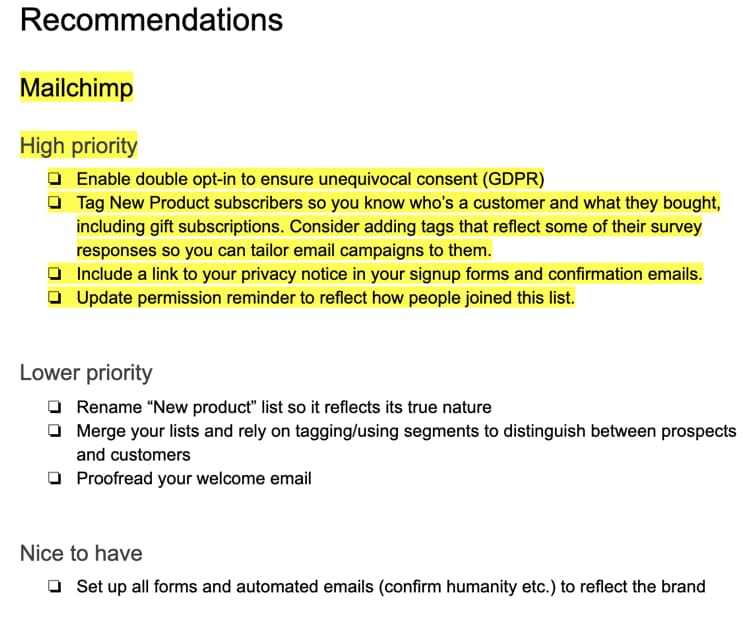
Sending a subscriber survey
The survey had two purposes:
- Tell us what made past customers buy and what kept other subscribers from buying
- Help me develop the messaging for the email campaign designed to drive sales traffic to the website
Our client was quick to come up with an attractive prize for the survey takers.
We agreed the questions within a couple of days. Then I set up a Typeform and invitation email to collect the responses.
Next, I drafted the email invitation. Our client was famous for their witty, provocative voice and tone. Emails tended to have evocative subject lines, but at around 21%, open rates were average. To get as much insight as possible, I needed to dramatically increase open and click through rates.
Because this email was so different from the (irregular) ones that had gone before, I chose a clear summary of the incentive:
“Take my 5-minute survey, get gorgeous knickers for Valentine’s day”
We also started the survey off with a rating question right there in the email — which was going to give us more engagement (people love interactive content):
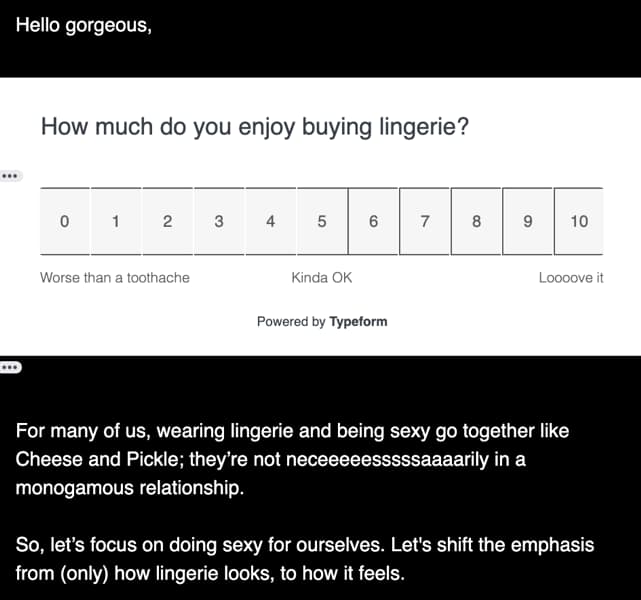
Analysing the subscriber survey
Next, I worked through the results to come up with a profile of our client’s ideal customer and their reasons to buy or not to buy:
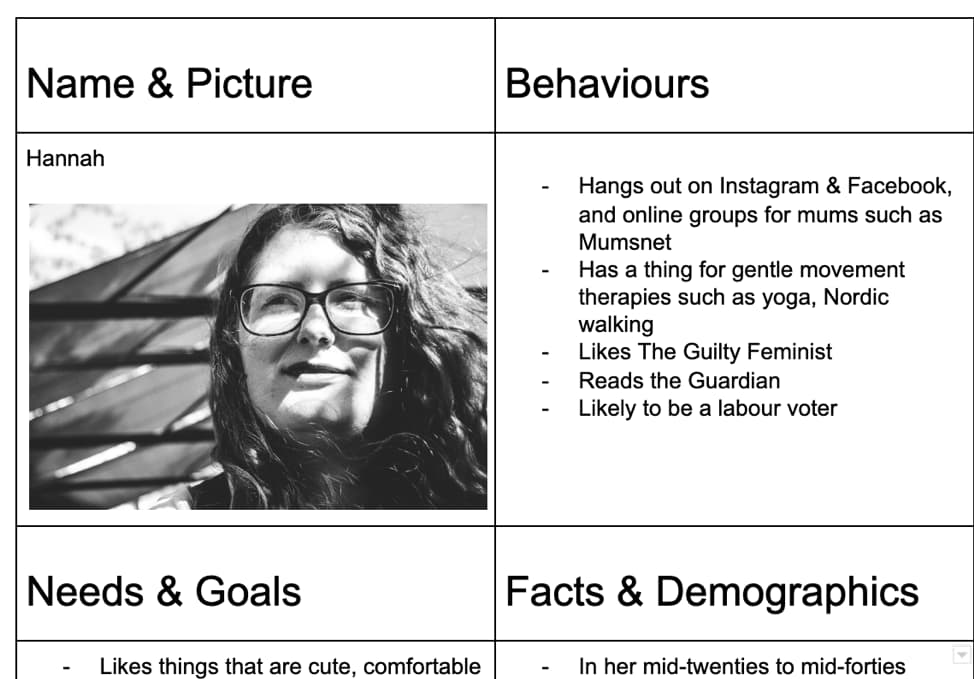
Planning the email campaign
Balancing value with asking for the sale
Including the survey email, we had 4 emails to play with for this campaign.
In line with this audience's values, I decided to get subscribers ready to buy by first getting them to shift their mindset. This was particularly important because we were writing to an old list of relatively “cool” subscribers who had not been nurtured in a long time.
So, while the first 3 emails were reminding people of the relationship they had with our client, email 4 was asking for the sale.
When planning an email sales campaign, it’s usually a good idea to roughly follow the 3:1 rule of adding value three times for each time we’re asking for the sale. New ideas and points of view are extremely valuable to readers, especially when presented in an entertaining way.
In this project, the pressure was on! We were limited to 4 emails in 4 weeks. So I decided to make two sales pitches — a humorous one and a more serious, informative one.
Defining the big idea for each email
The number 1 mistake we see in emails: diluting their power by overloading them with lots of different ideas.
To keep each email on point, I set the following big ideas:
- Survey email → let’s make buying lingerie great again
- Great gifts are based on shared values
- The holidays are about letting yourself off the hook
- Lingerie that allows freedom of choice and freedom of (physical) movement makes a perfectly loving holiday gift
Writing & designing the emails
Once we had agreed the campaign plan, I was ready to create the emails.
Because this brand has such a distinctive personality, capturing their voice and tone was essential. At the same time, these emails were more action-focused than previous ones. It was going to be interesting to see how subscribers would react.
“Training” readers to click through to valuable content
A lot of product-based businesses only ever send advertising newsletters. They’re all about the product and do not write about the company and founders, or the questions their customers face. Those emails are usually full of calls to action (CTAs). If those get no clicks, it’s usually because
- the email fails to engage the reader
- none of the products shown piques their interest
- there are too many CTAs, leading to analysis paralysis and decision fatigue.
Our client’s previous emails were quite different in that respect.
Many times, they did not include a single CTA. There was nothing for the reader to do at the end of the email, so they did not do anything.
It was important to change this pattern before the sales email in order to establish CTAs as the gateway to additional value — thereby increasing the likelihood of clicks in the sales email.
Email 2: Great gifts are based on shared values
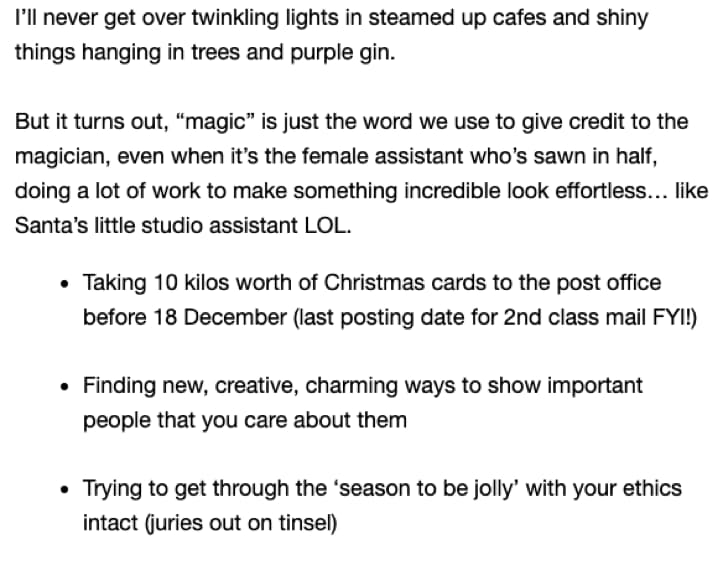
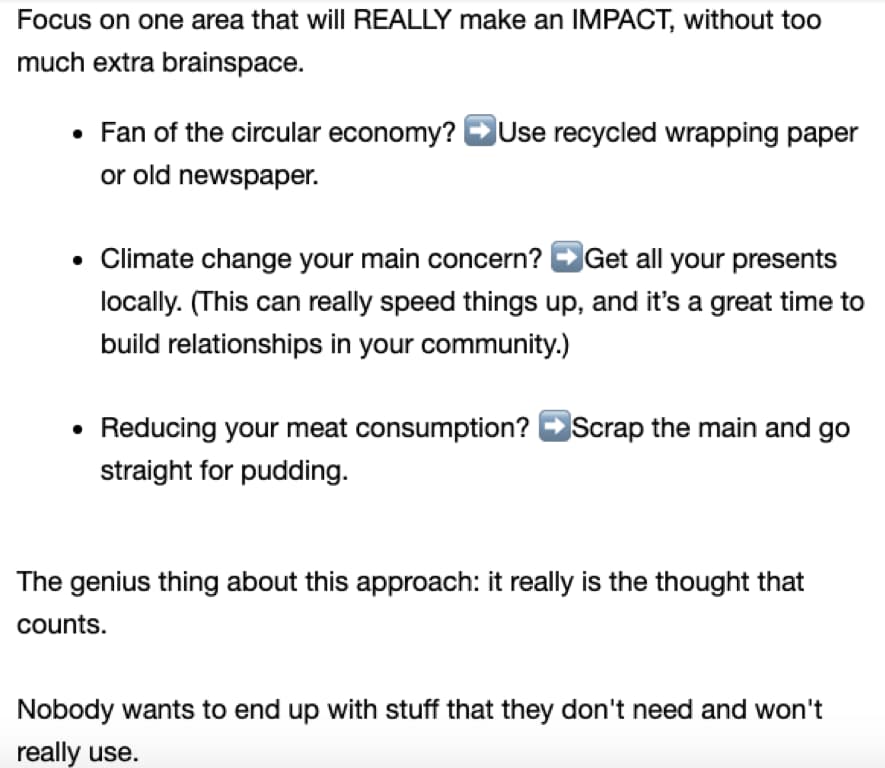
Emojis, bullet points and font styling are the only design elements in these emails. Making them look as if they're direct 1:1 messages from the brand owner to the reader.
Since writing these emails, I've learned not to use emoji in place of words, and to avoid writing in all caps for emphases: they hurt accessibility for people who use screen readers.
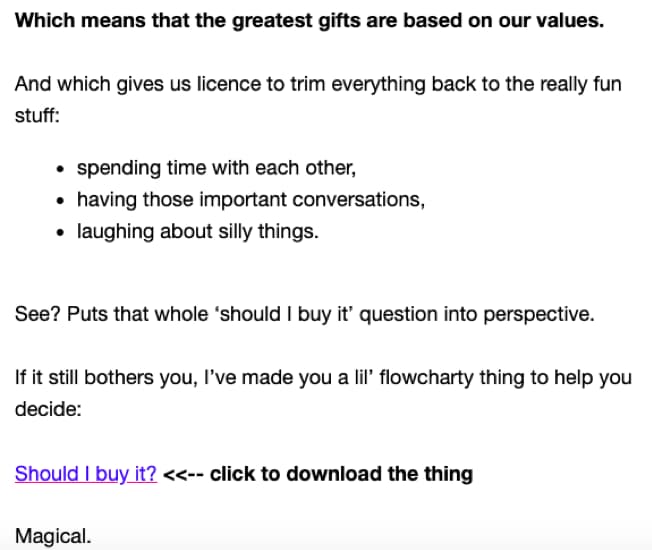
Email 3: The holidays are about letting yourself off the hook
The subject line of this email, “Seriously rhymey”, was in line with the brand’s previous, trademark style of combining the word “seriously” with an adjective.
Continuing the feminist theme, the email started with a confession:
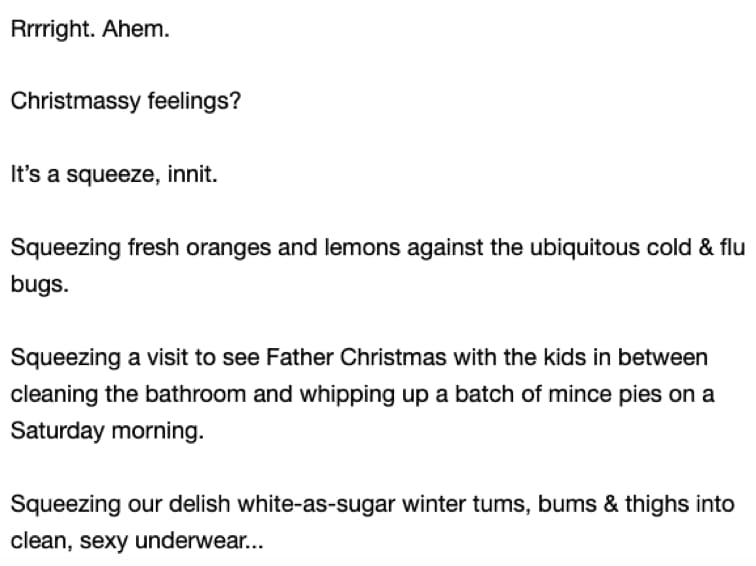
Playing with metaphor and tearing down the capitalist holiday spirit were completely in tune with how this brand shows up.
If I were to write this today, I'd change the final paragraph shown here to say: "Squeezing my delish white-as-sugar winter tums..." – because while the company founder and voice behind these emails is white, the readers are a diverse bunch. And this wording completely erases that fact.
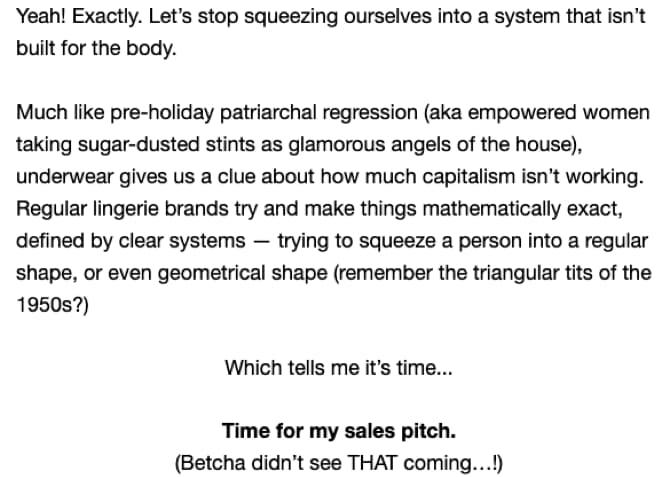
I had decided to write that sales pitch as a poem with internal and end rhymes (hat tip to Lucy with a Why for the inspiration!)
Reminiscent of theatre and the stage, this fits the burlesque aspects of the brand, as well as their style of selling in the most “obvious” ways, without trickery or undue pressure, while cautioning against overconsumption (sometimes called “sufficiency-driven” marketing).
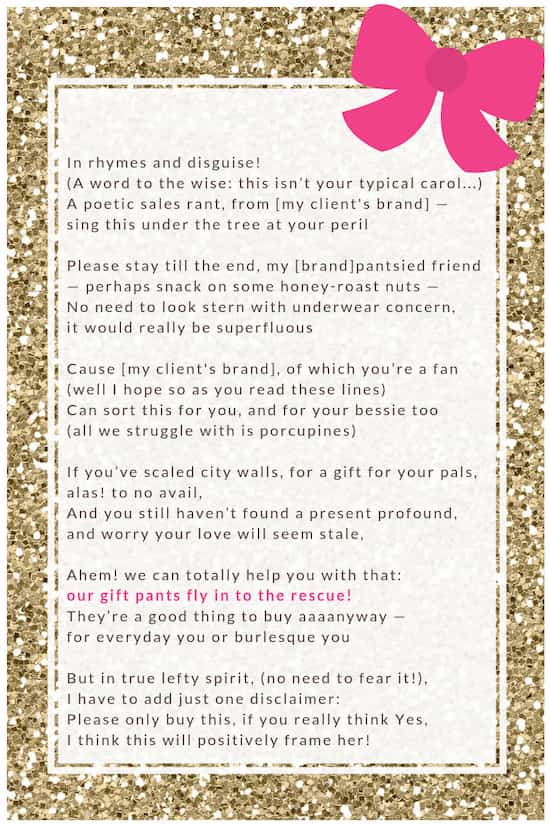
In rhymes and disguise!
(A word to the wise: this isn’t your typical carol…)
A poetic sales rant, from [my client’s brand] —
sing this under the tree at your perilPlease stay till the end, my [brand] pantsed friend
— perhaps snack on some honey-roast nuts —
No need to look stern with underwear concern,
it would really be superfluousCause [my client’s brand], of which you’re a fan
(well I hope so as you read these lines)
Can sort this for you, and for your bessie too
(all we struggle with is porcupines)If you’ve scaled city walls, for a gift for your pals,
alas! to no avail,
And you still haven’t found a present profound,
and worry your love will seem stale,Ahem! we can totally help you with that:
our gift pants fly in to the rescue!
They’re a good thing to buy aaaanyway —
for everyday you or burlesque youBut in true lefty spirit, (no need to fear it!),
I have to add just one disclaimer:
Please only buy this, if you really think Yes,
I think this will positively frame her!
The pink line in the poem is a clickable link, and there was another big, bold button at the end of the email.
Email 4: Asking for the sale
The final email had the subject “Seriously listy” — both a play on the popular Christmas song, “Santa Claus is Coming to Town”, and a means of foreshadowing the list at the end of the email.
It continued the slightly rant-y, empathetic style of the previous emails:
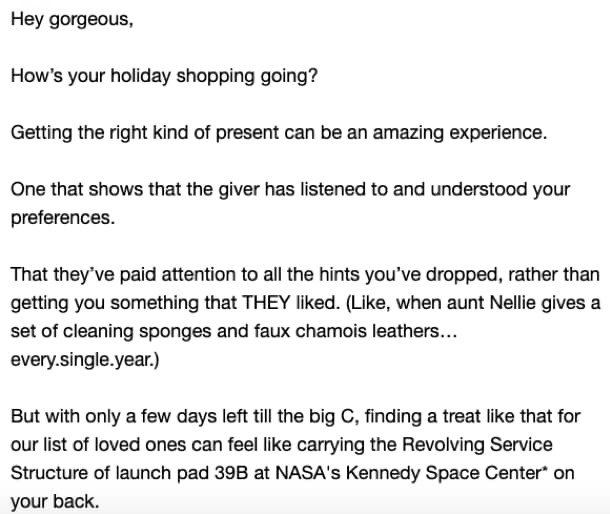
The middle part brought in customer reviews from Facebook (real-life screenshots for added authenticity) and a step-by-step guide to selecting the right product on the website, complete with product photos and links.
To finish off, I added a self-referential, ironic lead-in to a list of people who’d really benefit from our client’s lingerie — adding the value of a laugh or a giggle. Positive emotion and the likability factor of this approach were going to make readers more likely to consider a purchase.
![Screenshot of the start of the list in email 4: The marketing gurus tell me I can’t send you a sales email without adding value. So, if you’re struggling to think of someone you could gift a [product]… here are 6 Christmas cracker style ideas to get you going: Theresa May, because her pants should be as black as her soul (plus, imagine her in leopard print! Noooooo) Jim — this golfer dude needs spares, in case he has a hole in one. Katie Price, cause her head is finally back on her career and she’ll need some no-nonsense pants that go with “getting on with it”. Your sis, whose pants are on fire with all the little white lies about what she’s been up to on Saturday nights. Every single nun you know. I challenge you to find pants that go better with their habit… while allowing just a little bit of fun (she gets to decide how much)](https://from-scratch.net/wp-content/uploads/2025/06/email-4b.jpg)
Campaign Results
Let’s take a look at the overall campaign results.
In the following chart, the emails I planned, wrote and scheduled are marked in yellow.
There was a bit of a gap between the survey and our client booking us for the sales email campaign. Emails the client wrote and sent during that gap are marked in grey.
Despite the fact that we did not achieve the sales goal set for this campaign, we still consider it a success.
- The emails engaged readers, which is obvious from the sharp increase in open and click-through rates.
- Because of time and budget constraints, our client had decided to de-prioritise the website optimisation part – and this cost them sales. While that’s understandable, the email click-throughs did not result in the sales they’d hoped for. Readers were ready to buy, but there were still too many obstacles and friction points for them to make a purchase.
- Emails perform best when combined with a seamless e-commerce experience.
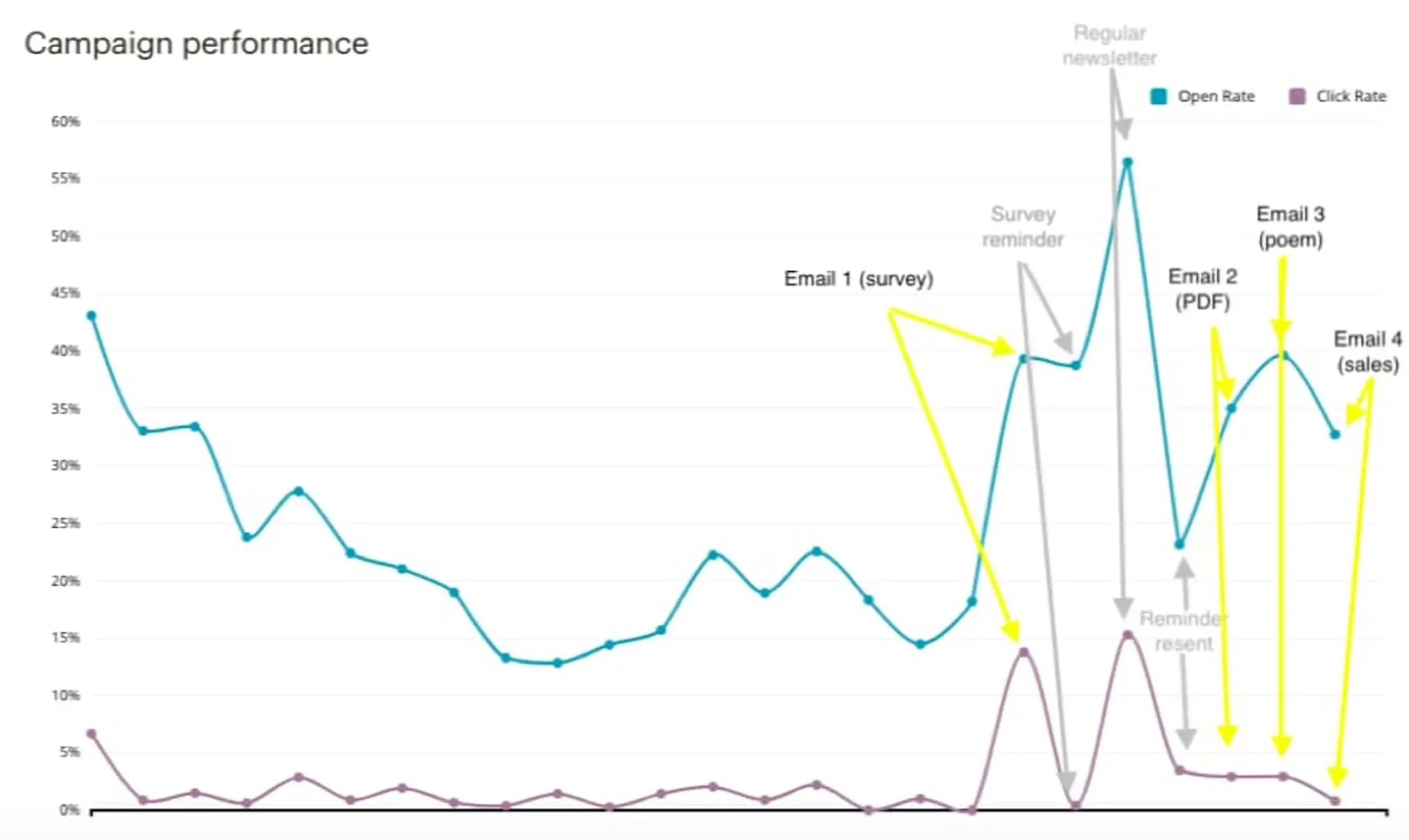
Learning = Winning
This campaign taught us 3 things:
- Don’t leave sales campaigns quite so late.
Email 4 (asking for the sale) went out on 18 December — at a time when most people’s inboxes were saturated with holiday sales messages. With holiday emails, you can’t really start too early. We’d recommend starting as soon as possible after Halloween (31 October). This also allows you to send appropriate follow-up emails to close the sale — for example, answering FAQs based on real engagement from your subscribers. - If you don’t usually sell via email, take the time to nurture your subscribers.
Make lots of different offers — some free, some at a small cost — to train them to expect value when they click those links and buttons in your emails. Work on the necessary mindset shifts that prepare your readers for the sale. Never, ever give in to the temptation to sell too soon in the process. - Optimise the relevant parts of your website before asking for the sale.
While we love seeing high click-through rates, we really want those clicks to convert into action. That’s unfortunately beyond the power of just the email alone — the website needs to convince and make saying YES as easy as possible. Start with a thorough website conversion copy audit, then make the necessary improvements before sending traffic to your online store.
Following these three principles will set up any sales email campaign for success — whether you decide to DIY it (perhaps with a bit of Conversion Coaching) or you decide to book us to write the emails for you.